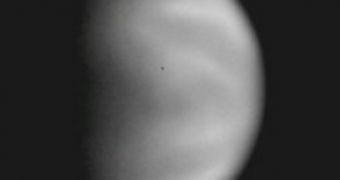Similar to the spacecraft Mars Express, the Venus Express is a project of the European Space Agency to study Venus. The Venus Express was the first mission to Venus, since the 1994 NASA's Magellan mission, but unlike NASA's spacecraft it is not designed to take direct pictures of the planets' surface, but it is equipped with instruments to study it through other methods. Mostly built from spare components from the Mars Express and the Rosetta spacecrafts, the Venus Express has been launched in November 2005, from Kazakhstan with the help of a Soyuz-Fregat Russian rocket.
The spacecraft was redirected towards a so-called transfer orbit around the Earth, only 1,5 hours after the liftoff to escape from the orbit around Earth and put it on a trajectory towards Venus, which took about 150 days to complete. This was the first mission conducted by the European Space Agency to explore the planet Venus.
The orbiter reached the planet in April 2006 and positioned itself in an elliptical orbit around the planet that takes 24 hours to complete. It is specially designed to pierce Venus' heavy atmosphere using different instruments and is equipped with a device similar to the MARSIS on board the Mars Express, called Analyzer of Space Plasmas and Energetic Atoms 4 also known as ASPERA-4, to study the interaction of the solar wind with the upper Venus' atmosphere or the ionosphere.
Nevertheless, the flight controllers from the ESA haven't been relentless in asking for the amateur astronomers' help, as the mission was extended at least until April 2009. The ESA specially created a web site on the Internet, where amateur astronomers can upload and download photographs of the planet, taken in different light wavelengths, such as infrared or ultraviolet, in a program called 'Venus Ground-Base Active Archive'.
The main goal of this program is to create a worldwide ground-based image to allow a continuous monitoring of the planet, as the Venus Express spacecraft nears its end of the mission.
The Internet web site includes detailed instructions on how to upload and download photos, a long list of FAQs and the names of the amateur astronomers who have the biggest number of accepted pictures and the view of the most recently submitted photographs.
Venus is the most visible planet on the night sky from planet Earth, being the brightest and can be observed in the northern hemisphere, low in the western sky just after the Sun has set. During most of the spring and summer seasons it can be seen high up in the sky, it disappears from view in the early fall, only to reappear in the end of August and will remain visible for the rest of the year.

 14 DAY TRIAL //
14 DAY TRIAL //